M39 Mount Lenses for Rangefinder Cameras
A Description of M39 Mount Lenses for Rangefinder Cameras - Other than Canon
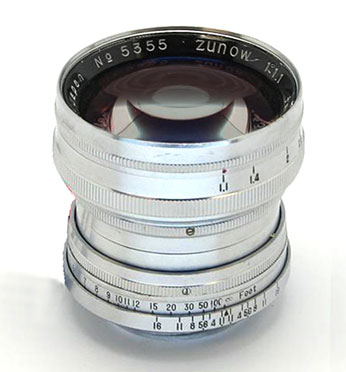
the Zunow 50mm f1.1 lens
M39 Screw-Mount Rangefinder Lenses
For its early Leica 35mm cameras, Leitz adopted a mount for interchangeable lenses which was 39 mm in diameter. It had a thread of threads turns per inch. The inch meaurement was used probably because Leitz was already manufacturing microscope lenses which used this form of thread. 4
Zunow Lens Designers
Zunow was founded by Suzuki Sakuta - 鈴木作太 prior to World War II. Hamano Michisaburō - 浜野道三郎 - a former lens designer of Nippon Kōgaku joined the company in 1941. Although completely destroyed during the war, design and production was restarted, and began designing large aperture lenses. The first prototypes were completed in 1950, and the company released the 50mm f1.1 Zunow in 1953 20.
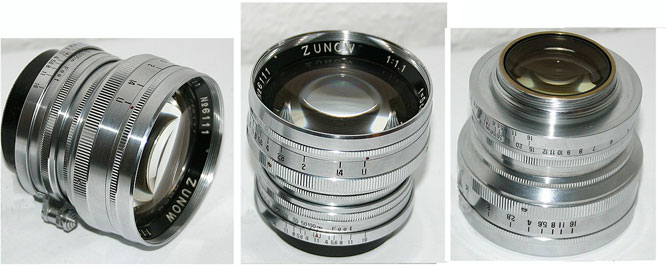
the Zunow 50mm f1.1
Zunow developed a series of fast rangefinder lenses, and later expanded into television camera lenses (also requiring wide apertures), and eventually designed a single lens reflex camera (outside the scope of this website). One of the other fine wide aperture lenses developed by Zunow was the 35mm f
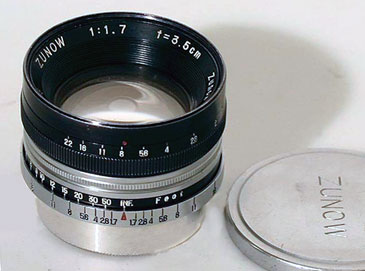
the Zunow 35mm f1.7 lens
Eastman Kodak Lenses
In the page on Other Rangefinder Cameras, the Kardon 35mm rangefinder produced in New York City for the US Army by Peter Kardon was described. The Army arranged for Eastman Kodak to produce lenses which could be used with the Kardon rangefinder. The usual normal lens for the Kardon was a Kodak Ektar 47mm f2.0. Eastman Kodak also produced a Kodak Lykemar 35mm f3.5 lens, which could also be used for Army close-up photography - perhaps for copy work.
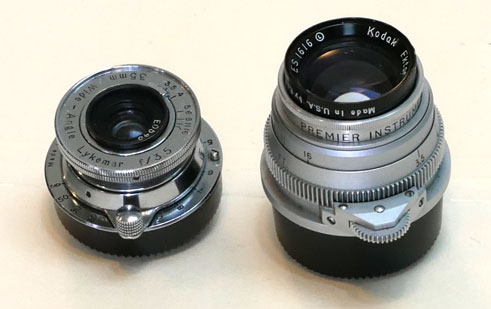
(l) Kodak Lykemar 35mm f3.5 lens and (r) the Kodak Ektar 47mm f2.0 lens
you can see the engraving "Premier Instrument Corporation" on the 47mm lens mount, indicating that Peter Kardon's Premier Instrument company manufactured the lens mount.
Voigtlander Nokton 50mm f1.5 Lens
One of the legendary 50mm lenses of the rangefinder era was the Voigtlander Nokton 50mm f1.5. This lens was designed by A. W. Ronnier for the German company in 1950. The design consisted of 7 elements in 4 groups
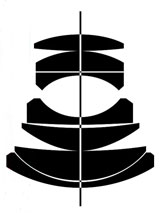
This lens was manufactured by Voigtlander in a number of different mounts, including fixed lenses and also in M39 screw mount versions. Its fine characteristics were long sought after by photographers until Voigtlander Cosina produced beginning in 1999 a modern version, the Voigtlander Nokton 50mm F1.5 Aspherical, available in different mounts. Still distinctive, however is the orignal lens construction, shown below.
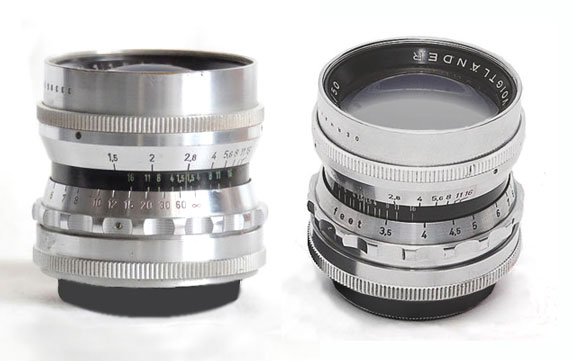
the original Voigtlander Nokton 50mm f1.5
Tanaka Kōgaku Tanar Lenses
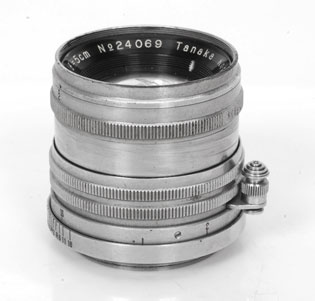
the Tanaka Kōgaku Tanar 50mm f2.0 lens
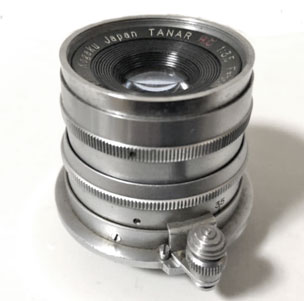
the Tanaka Kōgaku Tanar 50mm f3.5 lens
You can click on the links in the table below to consult other pages of the canonrangfinder.org site.
| Navigation: Click Below to Jump to Desired Subject Page | ||
|---|---|---|
| Canon Rangefinder Cameras - 1 | Canon Rangefinder Cameras - 2 | Canon Rangefinder Lenses |
| Canon Hansa | Canon IIAF, IIAX | Development Nikkor 50mm |
| Canon S | Canon IVSB2 | Canon 19mm |
| Canon J | Canon IIS2, IID2, IIF2 | Canon 25mm |
| Canon NS | Canon VT, Canon L2 | Canon 28mm |
| Canon JS | Canon L1, L3 | Canon 35mm |
| Canon S-I | Canon VT Deluxe | Canon 50mm |
| Canon J-II | Canon VL, VL2 | Canon 85mm |
| Canon S-II | Canon VI-L, VI-T | Canon 100mm |
| Canon IIB | Canon P | Canon 135mm |
| Canon III, IIC, IV | Canon 7 | Canon 200mm-1000mm |
| Canon IIIA, IVF, IVS | Canon 7s | Canon Accessories |
| Canon IIA, IID, IID1 | Nicca Rangefinders | Canon Finders |
| Canon IVSB | Minolta Rangefinders | Minolta Lenses |
| Canon IIF, IIS | Other Rangefinders | other M39 lenses |
| Go to canonrangefinder.com home page | ||
Any additions or corrections to these pages would be welcome simply by contacting this site as shown at the foot of this page .
Footnotes:
1 Dechert, Peter. Canon Rangefinder Cameras 1933-1968. Hove Collectors Books. West Sussex, United Kingdom. 1985. ISBN 0-906447-30-5.
Peter Dechert's book is the most important expert source of information regarding Canon Rangefinder Cameras.
2 Kitchingman, Peter. Canon M39 Rangefinder Lenses 1939-1971. A Collector's Guide. Published by Peter Kitchingman. Perth, Australia. 2008. ISBN 978-0-646-48144-9.
Peter Kitchingman's book is the definitive study of the more than three decades of M39 format camera lenses developed for Canon Rangefinder Cameras.
3 Nostalgic Canon Camera Book. 懐かしいキヤノン EI Publishing Co. Ltd. Tokyo, Japan. June 2003.
Peter Kitchingman's book is the definitive study of the more than three decades of M39 format camera lenses developed for Canon Rangefinder Cameras.
4 "Canon Camera Museum" history website. https://global.canon/en/c-museum/history/ published by Canon, Inc. accessed in 2019.
5 Rajner, Hans P. (author), John Wade (editor). Leica Copies. Classic Collections Publications. London, UK. ISBN 13: 9781874485056
Hans P. Rajner's book is an excellently detailed and carefully researched study of camera from around the world which used the Leica M39 lens mount and the same lens to film plane distance.
7 Dechert, Peter. Canon Single Lens Reflex Cameras 1959-1991. Historical Camera Publications. Yakima, Washington. 1992. ISBN 1-879561-04-2.
8 Tomlinson, Shawn M. The Film Photography Book. Lulu Pulbications. 2016. ISBN: 9781365263972
9 Sartorius., Ghester. Identifying Leica Lenses. Classic Camera 19. Tokyo, Japan. 2001. ISBN 4-257-12029-0
10 website http://www.nicovandijk.net/rflensmatrix.htm consulted 2019.
11 O'Reagan, Douglas M. Allied Exploitation of German Science after World War II. Johns Hopkins University Press. Baltimore, Maryland. 2019. ISBN 9781421428888
12 website www.canonrangefinder.servehttp.com consulted 2008.
13 Minolta expert Andrea Aprà has posted information on minoltarangefinders group and other groups and further detailed information by email. (thanks Andrea !)
14 website http://www.collection-appareils.fr/objectifs/ consulted 2019.
15 Small, Marc James. Non-Leitz Leica Thread-Mount Lenses. Wittig Books. Hückelhoven, Germany. 1997. ISBN 3-930359-47-2.
16 the Nikon Corporation website: https://imaging.nikon.com/history/ consulted 2019.
17 p 152. Ray, Sidney F. Photographic Lens ISBN 9780240510323
18 website http://www.rokkorfiles.com/Lens%20History.html accessed 2019
19 Katz, Jerome. The Kardon camera story: a dedication to Peter Kardon, great American patriot & pioneer. SJF Enterprises. New York, New York. 1977.
20 camerapedia.fandom.com/wiki/Zunow accessed 2019.
If you have any comments or questions about this Canon Rangefinder site, please e-mail me (Larry Huffman) at e-mail address: [email protected]